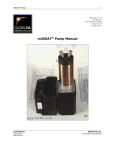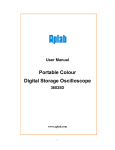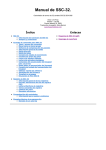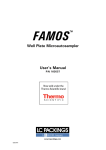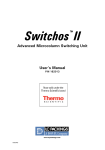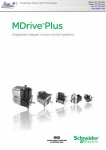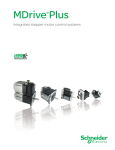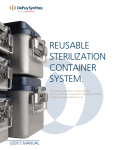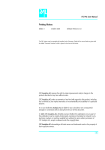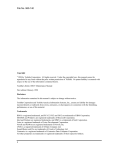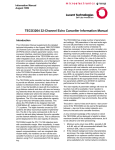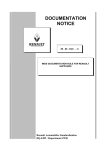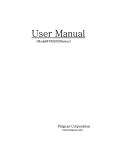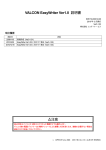Download milliGAT® Pump Manual
Transcript
milliGAT® Pump 1 684 Sixth Ave FI PO Box 480 Fox Island, WA, 98333 253-549-2223 253-549-2283 milliGAT® Pump Manual User Manual Version 2.12 June 2, 2005 Global FIA, Inc. Tech Support: 253-549-2223 milliGAT® Pump 2 The information in this manual has been carefully checked and believed to be accurate; however, no responsibility is assumed for inaccuracies. Global FIA, Inc. maintains the right to make changes without further notice to products described in this manual to improve reliability, function, or design. Global FIA, Inc. does not assume any liability arising from the use or application of this product; neither does it convey any license under its patent rights. and are trademarks of Intelligent Motion Systems, Inc. Certain copyrighted figures and diagrams used in this manual are used with the permission of Intelligent Motion Systems, Inc. milliGAT® is a registered trademark of Global FIA, Inc. Fox Island, WA, USA. Global FIA, Inc. does not recommend the use of the milliGAT® pump in life support or applications where it may directly or indirectly threaten life or injury. See the Warranty and Disclaimer statement included in the back of this manual. © 2002-2005 Global FIA, Inc. All Rights Reserved User Manual Version 2.12 June 2, 2005 Global FIA, Inc. Tech Support: 253-549-2223 milliGAT® Pump 3 Contents 1. Pump Operation..................................................................................................................................................5 1.1 Principle of operation ..................................................................................................................................5 1.2 Installation and use......................................................................................................................................5 1.3 Additional reading .......................................................................................................................................6 1.4 Connections..................................................................................................................................................7 1.5 Fluid line connections..................................................................................................................................9 1.6 Serial Control of the milliGAT® Pump.......................................................................................................10 1.6.1 Establishing serial communications between a MicroLynx-4 and a host computer using RS-232 .......10 1.6.2 Communicating with multiple devices using RS-485 and a RS-232 to RS-485 converter ...................10 1.6.3 Communicating with multiple devices using RS-485 with the MicroLynx-4 as host ...........................10 1.6.4 Communicating with multiple MicroLynx-4 controllers with one MicroLynx-4 as host......................11 2. 1.7 Initialization ...............................................................................................................................................12 1.8 Sending Commands in Immediate Mode....................................................................................................13 1.9 Examples of some immediate pump commands .........................................................................................13 1.10 Pump units .................................................................................................................................................14 Pump maintenance ...........................................................................................................................................14 2.1.1 2.1.2 3. Routine maintenance .............................................................................................................................14 Routine cleaning ....................................................................................................................................15 Material compatibility......................................................................................................................................15 3.1 PTFE ..........................................................................................................................................................15 3.2 PAEK..........................................................................................................................................................15 3.3 Valcon P.....................................................................................................................................................15 3.4 Sapphire .....................................................................................................................................................16 3.5 Guidelines ..................................................................................................................................................16 4. Spare parts list ..................................................................................................................................................17 5. Technical Support.............................................................................................................................................17 6. Returning pumps to Global FIA......................................................................................................................17 7. Operational and technical specifications ........................................................................................................18 8. Appendix A – Technical details .......................................................................................................................19 8.1 Serial cable wiring .....................................................................................................................................19 User Manual Version 2.12 June 2, 2005 Global FIA, Inc. Tech Support: 253-549-2223 milliGAT® Pump 9. 4 8.2 Stepper motor wiring .................................................................................................................................20 8.3 Default values for controller variables ......................................................................................................21 8.4 Calculating MUNIT for different MSEL values .........................................................................................21 8.5 Backlash correction ...................................................................................................................................23 8.6 Upgrading the MicroLynx-4 firmware.......................................................................................................25 Appendix B - MicroLynx-4 Commands..........................................................................................................27 WARRANTY AND DISCLAIMER.........................................................................................................................28 User Manual Version 2.12 June 2, 2005 Global FIA, Inc. Tech Support: 253-549-2223 milliGAT® Pump 5 The microprocessor-controlled milliGAT® pump* consists of the pump / motor / gear assembly, a MicroLynx-4 micro-electric controller, a linear power supply (100 – 240 VAC to 24 VDC) and cables. 1. Pump Operation 1.1 Principle of operation Within the pump casing, there is a rotor that is fitted with four 1/8” (3mm) pistons. This rotor seals up against the stator end cap. The stator end cap has an inlet and outlet port. These are coupled to an inlet channel in the shape of an arc and a similar outlet channel. A cam governs the back and forth displacement of the spring loaded pistons. The piston stroke is also 1/8” (3mm). As the rotor turns, one piston moving over the outlet channel dispenses fluid, one piston moving over the inlet channel is filled with fluid, and the other two pistons are moving between the fill and empty ports. The transitions from one piston to the next have been engineered to give near seamless fluid flow. A stepper motor governs rotation rate and direction. Flow direction is determined by the direction of rotation. Each piston delivers 25 µL, smaller volumes are achieved by micro-stepping the motor. One revolution of the pump displaces 100 µL and at any one time, there is 50 µL of fluid in the pump. This design allows bi-directional smooth flow over a wide range of flow rates. In the event of a deadhead blockage, the rotor moves away from the stator and fluid leaks from one of the pumps leak ports. Pistons are Teflon tipped and the Teflon tip is longer than the piston stroke thereby ensuring that the wetted surface of the sapphire piston chamber is not exposed to air. This has a positive implication for wear life as crystals of dried dissolved solids cannot scratch the seal surface. Being a positive displacement pump, the milliGAT® is self priming and can tolerate gas in the fluid lines. 1.2 Installation and use The mounting points of the pump and controller are given in Figure 1 together with the external dimensions of each module†. For best results, the milliGAT pump must be orientated with its ports facing up. If the pump is orientated in any other direction, bubbles may be trapped in the internal chambers of the pump. * US Pat No. 6,079,313 issued to Global FIA, Inc. An optional right angle drive (part number: RAD) is available. User Manual † Version 2.12 June 2, 2005 Global FIA, Inc. Tech Support: 253-549-2223 milliGAT® Pump 6 Figure 1: Mounting points and external dimensions The controller should be mounted in such a way to allow adequate cooling. If the cooling fan is obstructed the controller may overheat. 1.3 Additional reading The MicroLynx-4 is a powerful pump controller with many functions not described in this pamphlet. For a more in-depth discussion of the MicroLynx-4 controller, refer to the MicroLynx-4 manual available in Adobe Acrobat format on the CD supplied with the system or as a download from the Intelligent Motion Systems web site, www.imshome.com. User Manual Version 2.12 June 2, 2005 Global FIA, Inc. Tech Support: 253-549-2223 milliGAT® Pump 1.4 7 Connections NOTE! It is a good practice to only apply power to the power supply after all connections have been made. Failure to do so may destroy the controller. Take precautions to avoid static discharges to the controller. Figure 2 indicates how the pump and power supply are to be connected to the MicroLynx. Figure 2: Power connection for MicroLynx-4 and Pump Caution – The power connector is keyed - be careful not to plug the power connector in incorrectly – this could result in overheating and damage to the pump and MicroLynx-4 controller. Figure 3 shows how to connect an RS-232 serial port to the MicroLynx. Figure 3: milliGAT® pump cabling diagram with RS-232 connection User Manual Version 2.12 June 2, 2005 Global FIA, Inc. Tech Support: 253-549-2223 milliGAT® Pump 8 Figure 4 indicates two possibilities for connecting the controller to an RS-485 port. In the inset, the RS-485 pins on the MicroLynx-4 are connected to the A and B pins of a 2-wire RS-485 port. In the main diagram, the Receive pins on the MicroLynx-4 are connected to the corresponding Transmit pins on the RS-485 port and the Transmit pins on the MicroLynx-4 are connected to the Receive pins on the RS-485 port. Figure 4: milliGAT® communication cabling with RS-485 connection In a third possible arrangement, the MicroLynx-4 is coupled to the PC via a RS-232 connection and acts as a host for communication to other devices on a RS-485 network. This arrangement is represented schematically in Figure 5 for subsequent communication on a 2-wire RS-485 loop. User Manual Version 2.12 June 2, 2005 Global FIA, Inc. Tech Support: 253-549-2223 milliGAT® Pump 9 Figure 5: milliGAT® communication cabling with RS-232 and RS-485 connections 1.5 Fluid line connections The milliGAT® has two 10-32 threaded female ports. If you look carefully, you will see that they are labeled A and B. Port A is the inlet and port B is the outlet for positive pump movements. A set of 10-32 finger-tight fittings and ferrules are supplied with the pump. For additional fittings refer to §4 for appropriate part numbers. These fittings are available from your supplier. For best results, use 1/16” (1.59 mm) OD plastic tubing. 1. The leak-tightness and integrity of the fitting is dependent upon tubing preparation and the correct procedure in making up the fitting. 2. To avoid unswept volumes and a good seal, ensure that the tubing is cut square and is free of burs or cut debris. 3. Slide the nut and ferrule onto the tubing in the order shown in Figure 6. Either hex or finger-tight nuts may be used. Figure 6: 10-32 fitting 4. Insert this assembly into the 10-32 female port on the pump, screwing the nut in two or three turns. User Manual Version 2.12 June 2, 2005 Global FIA, Inc. Tech Support: 253-549-2223 milliGAT® Pump 10 5. Push the tubing all the way forward into the detail so that it seats firmly. This is essential for a proper Zero Dead Volume connection. 6. Turn the nut into the detail until it is finger-tight. 7. Remove the fitting and inspect it. The tubing should protrude past the ferrule by approximately 2mm. 8. When made up properly, the ferrule may be free to spin axially on the tubing, but should have no lateral movement along the tubing. If the ferrule moves laterally, reinstall the fitting into the detail and tighten it another 1/8 turn past finger tight. 9. Remove, re-inspect, and repeat, if necessary. 1.6 Serial Control of the milliGAT® Pump The pump is controlled by means of serial commands that are sent to the MicroLynx-4 controller. 1.6.1 Establishing serial communications between a MicroLynx-4 and a host computer using RS-232 1. Connect the cables as indicated in Figure 3. 2. Run a Terminal emulation program such as IMS Lynx Terminal, Windows Terminal or ProComm. 3. Configure the communication settings in the software to 9600 baud, no parity, 8 data bits, 1 stop bit, and with no hardware or software handshaking. 4. Power up the pump. An identifying string should be displayed on the screen, or the resident program (if there is one) will commence. If not, power down the pump. Ensure that all cables are properly connected and that the communication settings are correct. Power the pump up again. 1.6.2 Communicating with multiple slave devices using RS-485 and a RS232 to RS-485 converter 1. Using an RS-232 connection set the following system variables HOST=0 ECHO 2=0 for full duplex 4-wire RS-485 communication Or HOST=0 ECHO 2=1 for half duplex 2-wire RS-485 communication 2. Connect cables as shown in Figure 4. 3. Follow steps 2 through 4 in §1.6.1. 1.6.3 Communicating with multiple slave devices using RS-485 with the MicroLynx-4 as host 1. Using an RS-232 connection set the following system variables HOST=1 ECHO 2=0 for full duplex 4-wire RS-485 communication Or HOST=1 User Manual Version 2.12 June 2, 2005 Global FIA, Inc. Tech Support: 253-549-2223 milliGAT® Pump 11 ECHO 2=1 for half duplex 2-wire RS-485 communication 2. Connect cables as shown in Figure 5. 3. Follow steps 2 through 4 in §1.6.1. 1.6.4 Communicating with multiple MicroLynx-4 controllers with one MicroLynx-4 as host This mode of operation is also called Party mode. 1. Using an RS-232 connection to only the first MicroLynx-4, set the following system variables. HOST=1 ECHO 2=0 for full duplex 4-wire RS-485 communication Or HOST=1 ECHO 2=1 for half duplex 2-wire RS-485 communication 2. Save these settings by issuing the SAVE command. This controller is now designated as the host. 3. Connect cables as shown in Figure 5 and Table 5 to the slave controllers. It is preferable to use 4-wire RS-485 communication. Note that the RX pins on the host are wired to the TX pins on the slave controllers and the TX pins on the host are wired to the RX pins on the slave controllers. Connection from one slave controller to the next is RX to RX and TX to TX. 4. Set the address switches on the side of each controller to a unique address per Table 1. Note addresses are case sensitive. 5. Cycle power (remove power, pause until LED goes out, then reapply power) or send a Ctrl-C from the keyboard. The MicroLynx-4 is now in party mode and all communications directed to this unit must begin with the address you picked from Table 1. Furthermore, all communications must be terminated with a Ctrl-J (line feed) and NOT a carriage return (Enter key). There will not be any sign on message. All units will now be in party mode. NOTE: while in party mode, you must precede a command with the address and terminate with a Ctrl-J! For example, ASlew 10[Ctrl-J]. If you press Enter by mistake, just press Ctrl-J to send the command. If commands appear not to be getting through, press Ctrl-J to set all controllers to receive mode again. 6. Test by sending the command APRINT VER if A is a valid address. You should receive the line; VER =x.xx. 7. To obtain full duplex communication for each device type aECHO 2=0[Ctrl-J], where “a” is the devices address from Table 1. Save the new setting by typing aSAVE[Ctrl-J], where “a” is the devices address from Table 1. When using the dip switches to set addresses, all addresses are in uppercase. If you use a lower case addresses or an invalid address, all MicroLynx devices will stop receiving until Ctrl-J is pressed. 8. When in party mode there is no sign on message, but you can check for communication to a specific device by monitoring the pilot light and then press Ctrl-C, the pilot light should go off and then on again. User Manual Version 2.12 June 2, 2005 Global FIA, Inc. Tech Support: 253-549-2223 milliGAT® Pump 12 Table 1: Party mode address settings Address None A B C D E F G 1.7 A2 Off Off Off Off On On On On A1 Off Off On On Off Off On On A0 Off On Off On Off On Off On Initialization The controller operates in one of three modes: • Immediate mode where commands typed in a terminal program are immediately executed by the controller. This is the most common mode for controlling the milliGAT® pump. • Execute mode is used when a program is executed. The program is executed in response to an EXEC instruction or in response to a specified input. This mode of operation is also discussed in more detail in the Lynx family product manual available in pdf format (see Lynx Manual xx_xx_xxxx.pdf) on the CD supplied with the pump. • Program mode is used when entering programs for the MicroLynx-4. Program mode is initiated and terminated by typing PGM and is described in more detail in the Lynx family product manual. When the pump controller is powered up and successful communication between the host computer and the controller has been established, and if there is no resident program, the controller will start up in Immediate mode. A start up message similar to the following is broadcast to the host computer: Program copyright © 1996-2001 by: Intelligent Motion Systems, Inc Marlborough CT 06447 Ver 1.4 Ser A130000123 A When the pump is shipped a short resident program is installed and allows a few simple configuration options. Any label in a resident program in the MicroLynx can be called by simply typing its label name. For example, if a program contains a label INIT, typing INIT in the terminal program (or Terminal window of LynxTerm) will execute the code following the label INIT. In its default factory configuration, typing INIT will initialize all system variables to their factory pump defaults. User Manual Version 2.12 June 2, 2005 Global FIA, Inc. Tech Support: 253-549-2223 milliGAT® Pump 13 The controller is initialized with start up conditions given in Table 7 in the Appendix. It is possible to change and save the values of these variables in the controller’s non-volatile memory. Note: The values of the variables should only be changed by a qualified person as changing some variables may have a drastic impact on the pump’s operation. 1.8 Sending Commands in Immediate Mode Once serial communication has been established and if the controller is in Immediate mode, simply typing the commands from the terminal program (or the Terminal window of LynxTerm) or issuing them from your custom software will activate the pump. The Lynx family product manual provides a full description of all the commands that can be sent to the controller. Appendix B - MicroLynx-4 Commands provides list of selected MicroLynx-4 commands. Table 2 provides the basic commands necessary to control the pump. When the controller receives a valid command it returns a > prompt, if the command is not valid, the controller returns a ? prompt. Table 2: Basic pump commands SLEW Description: Sets commands Example: VM=20 VM MOVR SSTP 1.9 Description: Pump continuously at the specified flow rate Example: SLEW=20 the flow rate for pump Description: Pumps the specified volume, pump direction is determined by the sign Example: MOVR=–100 Description: Stops pump movement‡ Example: SSTP Min Max Units 0.0005 167 µL/sec Min Max Units 0.001 167 µL/sec Min Max Units ±0.001 ± 1015 µL Min Max Units Examples of some immediate pump commands The commands to achieve the following pump sequence are given in the second column of the table below. If the pump is in its default configuration, it will be in a micro stepping mode. (You can re-establish pump factory settings at any time by typing INIT. To save settings in permanent memory, type SAVE.) ‡ Pressing the ESC key will also halt a pump action User Manual Version 2.12 June 2, 2005 Global FIA, Inc. Tech Support: 253-549-2223 milliGAT® Pump 14 Description Aspirate§ 0.5µL at 5µL/sec Dispense 1000µL at 100µL/sec Pump continuously at 50µL/sec Stop the pump Command VM=5 MOVR=-0.5 VM=100 MOVR=1000 SLEW=50 SSTP Each command is sent to the controller by hitting the Enter key (except when in party mode, then Ctrl-J is used). When entering these commands, always ensure that the controller returns a > prompt. If it returns a ? prompt, then there is an error in the command and you must retype it. You can clear the error by typing PRINT ERROR. Error codes are given in the MicroLynx manual. 1.10 Pump units The default units for the pump are µL (volumes), µL/sec (flow rates and slew rates), and µL/sec2 (flow acceleration rates). 2. Pump maintenance There are NO user serviceable parts inside the pump. Opening the pump by removing, or even loosening, the hex bolts that hold the pump together will void the pump’s Limited Warranty. To obtain optimum performance and maximum life from the milliGAT® pump it is important to follow the recommended cleaning and maintenance instructions. 2.1.1 Routine maintenance • Flush the pump thoroughly with distilled or de-ionized water after each use. Store the pump dry. • Avoid running the pump dry for extended periods. The pump is self priming and will dispel entrapped bubbles when orientated vertically. • Inspect the pump for leaks and correct any problems immediately. Liquid entering the motor housing could damage the motor and gear assembly. The pump is equipped with a leak port. Leakage from this port indicates excessive back pressure and unreliable pumping action. • Wipe up all spills on and around the pump immediately. If fluid is seen coming from the leak port, flush the internals of the pump through the leak port with distilled water and then isopropyl alcohol (IPA) and allow it to dry before further use. • If the flow manifold is such that leaks through the leak port are frequent, then it is a good idea to incorporate a pressure relief valve (Part No.: PRV-100) downstream of the pump to allow over pressure situations to leak safely to waste. § Switch inlet and outlet ports if flow direction is reversed User Manual Version 2.12 June 2, 2005 Global FIA, Inc. Tech Support: 253-549-2223 milliGAT® Pump 15 2.1.2 Routine cleaning The pump fluid path can be cleaned with one of the following cleaning solutions 1. Weak detergent wash 2. Weak acid and base wash: pump 5 mL of 0.1N NaOH followed by 5 mL of water followed by 5 mL of 0.1N HCl, followed by 10 mL of water. 3. Weak bleach wash: pump 5 mL of a 10% beach solution followed by 10 mL of water. All polymers used in the pump can withstand the temperatures associated with autoclaving. The pump head is easily removed from the motor and gear assembly to facilitate sterilization. It is permissible to autoclave the milliGAT® pump. Contact Tech Support to discuss the best way of doing this. 3. Material compatibility Wetted materials used in the milliGAT® are described below. 3.1 PTFE The piston tips are made from PTFE. Polytetrafluoroethylene is the generic name for the class of materials such as Teflon®. It offers superior chemical resistance and lends itself to good sealing characteristics. Because it’s so easy to handle, it is often used in low pressure situations such as the milliGAT®. Compounds of low molecular weight can permeate PTFE. Fumes of strong acids such as hydrochloric acid can permeate the PTFE and should be constantly purged from the internals of the pump by blowing instrument air in through one of the leak ports. A barbed fitting (Cat No.: P-N) is available to allow convenient hookup of an air line. 3.2 PAEK The pump port end cap makes use of a PAEK-based composite. Polyaryletherketone is the generic name for the family of polyketone compounds. PAEK includes PEK, PEEK, PEKK, and PEKEKK, which differ in physical properties and, to a lesser degree, in inertness. This composite resists all common HPLC solvents and dilute acids and bases. However, concentrated or prolonged use of halogenated solvents may cause the polymer to swell. Avoid concentrated sulfuric or nitric acids (over 10%) and see guidelines in §3.5. 3.3 Valcon P The pump rotor is made from Valcon P. This composite, the majority of which is PTFE and carbon, has been used extensively in many analytical applications that use Valco valves. It is routinely used in other applications at 1000 psi, 75°C, and can also be used at temperatures approaching 200°C with decreased sealing tension. User Manual Version 2.12 June 2, 2005 Global FIA, Inc. Tech Support: 253-549-2223 milliGAT® Pump 3.4 16 Sapphire The milliGAT® piston chambers are made of sapphire and are sealed in place with a Viton® o-ring. Sapphire has a unique set of properties including high strength, hardness, surface smoothness, and excellent chemical compatibility. It is commonly used in applications where a combination of exceptional mechanical and chemical properties is essential. 3.5 Guidelines Specific reagent combinations should be tested to ensure compatibility with pump components. Since the least chemically inert component in these composites is PEEK, for optimum component life time, the following guidelines** given for PEEK should be followed: Acids and bases No stronger than 1 M H2SO4 Resistant to 10% HCl Resistant to 20% HF Not Resistant to 70% (no data on lower conc.) Resistant to 20% HNO3 Dibutylamine in Toluene Not Rated TBAH Not Rated (Dionex uses PEEK as column material at 1 mM) NaOH Resistant Resistant H2S Not Rated CH3SH acetone Resistant methyl ethyl ketone Resistant at Room Temp. methyl alcohol Resistant toluene Resistant at Room Temp. xylene Resistant chloroform Resistant chlorobenzene Resistant at Room Temp. iodine/iodide in water Not Rated sodium hypochlorite (household bleach) Resistant at Room Temp. permanganate Resistant at Room Temp. hexane Resistant at Room Temp. ** Corrosion Resistance Tables, Schweitzer, Marcel Dekker, 1991 www.zeusinc.com/product_sheets/resins/peek/chemical_compatibility.html User Manual Version 2.12 June 2, 2005 Global FIA, Inc. Tech Support: 253-549-2223 milliGAT® Pump 17 4. Spare parts list Part No. ZN1FPK-10 ZF1PK-10 SER-232 SER-485 SER-P-n ML-4 MG-PS-N MG-MAN MD17-1 IMS-CD I-23688 CP-RAD PRV-100 PRV-40 Description Zero dead volume finger-tight fitting with 10-32 thread(10 pack) Zero dead volume ferrule (10 pack) RS-232 cable (9 pin D-shell to 10 pin ribbon connector) RS-485 cable (7 pin connector to stripped wires) Party mode serial cable with “n” slave controllers MicroLynx controller 24 VDC power supply milliGAT® manual Stepper motor (DIN 17) with 4.75x gearbox IMS program CD Pump motor cable Right-angle drive Pressure relief valve (100 psi) Pressure relief valve (40 psi) 5. Technical Support All technical support for this product is handled by the Global FIA, Inc. facility on Fox Island, WA. 253-549-2223 (Telephone) 253-549-2283 (Fax) [email protected] (Email) Firmware updates for the MicroLynx-4 can be downloaded from www.IMSHome.com. 6. Returning pumps to Global FIA The following procedure must be followed when pumps are returned to Global FIA for repair: 1. Obtain a Return Merchandise Authorization number (RMA#) 2. Sign a decontamination report asserting that the pump has been decontaminated and is safe for technicians to work on it 3. Describe in detail a. what is wrong with the pump b. the environment in which it is used c. the fluids that have been through the pump d. your power and communications setup 4. Contact name, address, telephone number, email address 5. Return the pump to: Global FIA, Inc Attn: RMA# 684 Sixth Ave Fox Island, WA, 98333, USA User Manual Version 2.12 June 2, 2005 Global FIA, Inc. Tech Support: 253-549-2223 milliGAT® Pump 18 7. Operational and technical specifications Physical Specifications Dimensions Weight pump Weight motor and gear assy. Weight micro-electric controller Weight power supply Resolution MSEL=256 Pump volume range Pump speed range Back pressure Volume precision (C.O.V.) Fittings Fluid contact Power requirement Rest current draw Operational current draw Voltage Motor Type Gear Assembly Type Ratio Communications Type Baud rate Parity Data bits per character Stop bits Error checking Mode See Figure 1 520g 530g 300g 300g 243200 micro steps / 100µL 10 nL – 109 L or continuous flow 0.0005 – 167 µL/sec 100 psi <0.08% at 1.25 mL <0.3% at 125 µL 10-32 female thread with Valco detail PTFE, Sapphire, PAEK, Viton, and Valcon P 0 mA 1200 mA (Typ.) (peak 1600 mA at acceleration) 12-48 VDC, 24 VDC (Typ.) 2 Phase Bipolar (1.8º per step) Planetary 1:4.75 COM1 RS-232 COM2 RS-485 (RS-422) 9600 (default), 4800 - 38 800 bps None 8 1 None ASCII Environmental Operating Temperature Operating Humidity Storage Temperature User Manual Version 2.12 June 2, 2005 0 – 50°C < 90% non-condensing -20°C – 70°C Global FIA, Inc. Tech Support: 253-549-2223 milliGAT® Pump 19 8. Appendix A – Technical details 8.1 Serial cable wiring The pin outs for the serial cable are given in Figure 7. If the RS-232 interface is used, then only the RS-232 connections are wired through to an appropriate serial connector (usually a 9 pin D-Shell). The following table provides the connections for a standard RS-232 installation. Table 3: RS-232 pin outs 10 pin connector on MicroLynx-4 2 TX 3 RX 5 Gnd 9 pin Female D-Shell 2 RX 3 TX 5 Gnd If the RS-485 interface is used, then only the RS-485 connections are wired through to an appropriate connector. In some applications, only a single pair is used to communicate. The following table provides the connections for both situations. Table 4: RS-485 pin outs 10 pin connector on MicroLynx-4 6 RX+ 7 RX8 TX9 TX+ 10 Gnd 1 pair RS-485 2 pair RS-485 B A A B Gnd TX+ TXRXRX+ Gnd The MicroLynx-4 can also be used in a host mode where it is hooked to a computer via the RS-232 interface but then communicates with other devices via the RS-485 interface. In his mode the MicroLynx-4 must be configured as the host (HOST=1) and the two serial ports on the MicroLynx-4 must be configured for half duplex communication (Echo 1=1 and Echo 2=1). Where this communication layout is required, the following connection table pertains. User Manual Version 2.12 June 2, 2005 Global FIA, Inc. Tech Support: 253-549-2223 milliGAT® Pump 20 Table 5: RS-232 / RS-485 pin outs 9 pin Female D-Shell 2 RX 3 TX 5 Gnd MicroLynx 10 pin header 2 RX 3 TX 5 Gnd 6 RX+ 7 RX8 TX9 TX+ 10 Gnd MicroLynx 7 pin Phoenix 2 TX 1 RX 6 Gnd 4 RX+ 3 RX5 TX7 TX+ 6 Gnd 1 pair RS-485 2 pair RS-485 B A A B Gnd TX+ TXRXRX+ Gnd Figure 7: Pin outs on MicroLynx-4 8.2 Stepper motor wiring The stepper motor used is a bipolar motor with four leads. This motor is wired as indicated in Table 6. Table 6: Motor wiring Phase Phase A Phase Bar A Phase B Phase Bar B User Manual Version 2.12 June 2, 2005 Wire Color Black Red White Green Global FIA, Inc. Tech Support: 253-549-2223 milliGAT® Pump 8.3 21 Default values for controller variables The factory default parameters that may be changed by the user are listed in the following table. All other parameters are set to factory defaults described in the MicroLynx-4 manual. Note: The values of the variables should only be changed by a qualified person as changing some variables may have a drastic impact on the pump’s operation. Table 7: Factory settings for MicroLynx-4 variables Parameter Pump units Stepper motor pulses per pump unit Step resolution, pulses per step Max flow rate, µL/sec Initial flow rate, µL/sec Slew rate, µL/sec Acceleration rate, µL/sec2 Deceleration rate, µL/sec2 Motor hold current, % of 4A Motor run current, % of 4A Motor acceleration current, % of 4A Backlash enable Backlash mode Backlash amount, µL Holding current delay time Command MUNIT MSEL VM VI SLEW ACCL DECL MHC†† MRC‡‡ MAC BLE BLM BLSH HCDT Setting µL 2432 256 20 0.001 1000 1000 0 30 40 1 1 1.5 0 Minimum Maximum ±10-16 2 0.0005 0.0005 0.0001 1 1 0 1 1 0 0 0 0 ±1015 256 167 1 167 5000 5000 10 50 50 1 1 ±1015 5000 The present value of any variable can be determined by using the PRINT command, e.g. PRINT VI will display the present value for VI, the initial flow rate. The present value for all variables can be seen by typing PRINT ALL. To save changes to the default values, use the SAVE command. saved will be lost when the pump is powered down. 8.4 Changes not Calculating MUNIT for different MSEL values MUNIT is the variable that allows the conversion from stepper motor pulses to a more meaningful engineering unit. This means that instead of expressing pump flow rate in motor Hz or volume in terms of number of stepper motor steps, it is possible to express it in familiar units such as µL/sec and µL. Some users are more familiar with expressing flow rate in terms of a volume per minute. This is not conveniently accommodated in the milliGAT® controllers †† MHC>0 could cause heating of the motor when the pump is at rest MRC>30 could cause heating of the motor when the pump is running User Manual ‡‡ Version 2.12 June 2, 2005 Global FIA, Inc. Tech Support: 253-549-2223 milliGAT® Pump 22 because all rate and acceleration based parameters are expressed in terms of seconds. Changing MUNIT to a value that would give flow rates in terms of volume per minute would render volume and acceleration settings obscure. Table 8 provides a conversion table for selected flow rates. Table 8: Flow rate conversion table µL/sec 1.00 2.00 3.00 4.00 5.00 6.00 7.00 8.00 9.00 mL/min 0.06 0.12 0.18 0.24 0.30 0.36 0.42 0.48 0.54 µL/sec 10.00 20.00 40.00 50.00 60.00 70.00 80.00 90.00 100.00 mL/min 0.60 1.20 2.40 3.00 3.60 4.20 4.80 5.40 6.00 1.67 3.33 5.00 6.67 8.33 10.00 11.67 13.33 15.00 0.10 0.20 0.30 0.40 0.50 0.60 0.70 0.80 0.90 16.67 33.33 50.00 66.67 83.33 100.00 111.67 133.33 150.00 1.00 2.00 3.00 4.00 5.00 6.00 7.00 8.00 9.00 For the milliGAT® pump, MUNIT is calculated as follows: MUNIT = (step resolution ) * (360/motor step size) * (gear ratio) volume moved by one revolution of the pump in pump units MSEL sets the pump step resolution. For example, pump units in µL for a pump with a 1:4.75 gear box and a 1.8° stepper motor used in micro stepping mode (MSEL=256) with a pump with an internal capacity of 100µl. MUNIT = 256 * (360/1.8) * (4.75) 100 Note: all motor commands pertaining to motor velocity (flow rate) and acceleration are expressed in terms of seconds. In the above example, flow rates will be measured in µL/sec and volumes in µl, etc. User Manual Version 2.12 June 2, 2005 Global FIA, Inc. Tech Support: 253-549-2223 milliGAT® Pump 8.5 23 Backlash correction The MicroLynx-4 can be set up to automatically compensate for the mechanical variance in a system. The gearbox, motor to pump coupling, and certain internal pump components contribute to this variance. This variance (and therefore backlash compensation) is only applicable when the direction of flow changes. The microLynx-4 has a suite of commands to automatically compensate for the backlash. Table 9 lists the pertinent commands. Table 9: Automated backlash compensation Command BLE Description Backlash compensation enable flag BLM§§ BLSH Backlash compensation mode Backlash compensation amount in µL Setting Enable : BLE=1 Disable : BLE=0 BLM=1 BLSH=1.5*** When backlash compensation is enabled (BLE=1), a move in the opposite direction to the previous move will have the value of BLSH added to it in the direction of the present move. This will have the effect of taking up the backlash resulting from the change in direction. When there is no change in direction, no backlash compensation is necessary. The backlash of a specific pump is characteristic to that pump and is determined for each pump – motor combination. This value is listed on the Certificate of Conformance for the pump and is usually about 1.5 µL. If backlash is disabled, then whenever there is a change in direction, the volume dispensed will be less than the required volume by an amount equal to the backlash. You can check the backlash of the pump at any time by carrying out the following simple test sequence. 1. Prime the pump making sure that all bubbles have been purged from the pump. Aspirate a small 5 µL bubble into the outlet line of the pump so that you can visually observe movement of the liquid. 2. Set BLE=0. This will disable backlash compensation. 3. MOVR -5. This will cause the fluid in the outlet to move towards the pump. 4. MOVR 1.0. This will cause the fluid in the outlet to move away from the pump and represents a change in direction. Because you have disabled backlash compensation, the fluid in the outlet line will not actually move – the backlash has not been taken up yet. 5. Repeatedly issue MOVR 0.1 commands until you observe movement of the liquid. 6. The backlash is equivalent to 1.0 plus the number of 0.1 increments necessary before movement was observed. §§ There is an error in the Lynx manual 03_10_2000.pdf p. 3-48) in the description of BLM. The modes are incorrectly swapped. *** This amount may vary with extensive pump wear User Manual Global FIA, Inc. Version 2.12 June 2, 2005 Tech Support: 253-549-2223 milliGAT® Pump 24 7. You can determine the backlash more accurately by incrementing smaller volumes. If you do this, it is useful to use narrow bore tubing with an ID of 250 µm or less so that you can physically see the movement. 8. Set BLSH to the new determined value for backlash. 9. Set BLE=1 to enable backlash compensation. 10.Verify correct operation by moving the fluid back and forth the same volume. You should end up at the same spot. Of course, whenever you change direction, even though the pump is moving, for the first short period of time, you will not see movement of the fluid as the pump takes up the backlash. With backlash enabled, this is handled automatically. The MicroLynx has a powerful Program Mode. Using this mode, sequences and programs can be downloaded to the MicroLynx and thereby add considerable functionality. All pumps are shipped with a small memory resident program installed. This program is listed in Table 10. By issuing the command INIT at the command prompt, the sequences listed will be executed. Table 10: Configure.lxt Command Description Pgm 200 Switch to program mode and store program starting at memory position 200 Define label INIT–this sequence initializes pertinent variables Print start up text LBL INIT PRINT "milliGAT(TM)" PRINT "Fox Island, WA, 98333" PRINT "253-549-2223 www.milliGAT.com" PRINT Ver, "SER = ", Ser SET Ios 21=18,1,0,0,0 SET Mac=40 SET Mrc=30 SET Mhc=0 SET Msel=256 SET Munit=2432 SET Accl=1000 SET Decl=1000 SET Aclt=1 SET Dclt=1 SET Hcdt=0 SET Vm=20 SET Vi=0.001 SET Blsh=1.500 SET Ble=1 SET Blm=1 BR DONE LBL DONE PRINT ">"; END Pgm Print firmware version number and controller serial number Configure digital output to indicate pump is moving Set acceleration current to 40% of 4A Set run current to 30% of 4A Set holding current to o% of 4A Set 32 micro-steps per motor step Set pump units to a 304 Set acceleration rate to 1000 µL/sec2 Set acceleration rate to 1000 µL/sec2 Set acceleration type to 1 Set deceleration type to 1 Set holding current delay time to 0 Set flow rate to 20 µL/sec Set initial flow rate at start of ramp to 1 µL/sec Set backlash amount to 1.5µL Enable backlash Set backlash mode to 1 Branch to DONE label Define DONE label Print > prompt End program Exit program mode To download a program such as this to the MicroLynx: User Manual Version 2.12 June 2, 2005 Global FIA, Inc. Tech Support: 253-549-2223 milliGAT® Pump • • • • • 25 Type up the program in a suitable text editor such as Notepad. The IMSTerm software supplied on the IMS CD also has a useful editor. Only type up the commands in the Command column listed in Table 10. Clear the program space and variables in the MicroLynx by issuing the command RTFD. This will return the MicroLynx to IMS factory defaults. (The command CP 1,1 will simply clear the program space and will not change system variables). Download the program to the MicroLynx using a suitable terminal program such as Windows Terminal or the IMSTerm software supplied with the pump. Test correct operation by issuing the command INIT. The startup text should be displayed. Type SAVE to save the program and new settings to MicroLynx non-volatile memory. You can execute a saved program by typing either a label in the program or EXEC nnn where nnn is the line number at which execution should begin. To exit a program press the Esc key and type PGM to switch to Immediate mode. To delete the program from memory, type CP 1,1 and SAVE. 8.6 Upgrading the MicroLynx-4 firmware Periodically Intelligent Motion Systems releases a new version of the Controller Firmware for the MicroLynx-4 controller. The present version of your firmware can be determined by typing PRINT VER at the > prompt. The latest version of the firmware is available at http://www.imshome.com/software.html. Once the latest version has been downloaded and unzipped, the following procedure should be followed to install the new version. 1. Run LynxTerm and ensure communication between LynxTerm and the MicroLynx-4 controller. 2. Click on the Upgrade menu option. 3. Click the Next button to begin the process and then follow the on screen instructions as described below. 4. If you need to Save Pgms, Vars, and Flags, click the Save button, otherwise click Next. If you click the Save button, you will leave the Upgrade wizard and return to Immediate mode where you can manually save or upload variables and programs. 5. Locate and select the upgrade file and click Next. 6. Ensure that the serial cable is plugged in and click Next to setup the Comm. port. 7. Set the indexer upgrade DIP switch on the side of the MicroLynx-4 to the On position and click Next. The small status indicator LED on the controller will shine red. 8. Cycle power to the MicroLynx-4 and press Next. 9. Wait for Comms to be established and then press Upgrade. 10.Allow new firmware to download. User Manual Version 2.12 June 2, 2005 Global FIA, Inc. Tech Support: 253-549-2223 milliGAT® Pump 26 11.When it is finished downloading, power down the MicroLynx-4 and switch the Upgrade DIP switch back to Off and click Done. 12.Power up the system. The small status indicator LED on the controller will shine green. 13.Confirm that the new version is present by typing Print ver in the Comm Window at the > prompt. 14.Re-enter the system variables as specified in §8.3 and save these variables to non-volatile memory by typing SAVE. 15. Check that the values have been saved by cycling the power and then displaying one or more of the variables, e.g. Print MUNIT. User Manual Version 2.12 June 2, 2005 Global FIA, Inc. Tech Support: 253-549-2223 milliGAT® Pump 27 9. Appendix B - MicroLynx-4 Commands Command ACCL=n ACLT=n DCLT=n DECL=n SLEW n,m SSTP m VI=n VM=n MOVA n,m MOVR n,m MVG POS=n MAC=n MHC=n MRC=n MSEL=n MUNIT=n BLE=n BLM=n BLSH=n CTR1 ALL ERR ERROR FLAGS IP n PGM PRINT n SAVE SER VARS VER CP=n EXEC n LIST n <ESC> Ctrl-C BAUD=n DN=“n” ECHO=n PRMT PARTY User Manual Version 2.12 June 2, 2005 Description Peak acceleration value, µL/sec2 Acceleration type Deceleration type Peak deceleration rate, µL/sec2 Slew the motor at a constant velocity, m=0 use acceleration ramp, m=1 do not use acceleration ramp, velocity in µL/sec Stop the current motion, m=0 stop motion only, m=1 stop motion and program, m omitted is the same as m=0 Initial pump velocity, µL Maximum velocity of pump during a pump action, µL Move to an absolute pump position, n is position in µL, sign of n indicated direction, m=0 with deceleration, m=1 no deceleration, m=0 if omitted Dispense / aspirate, n is volume in µL, sign of n indicates direction, m=0 with deceleration, m=1 no deceleration, m=0 if omitted Flag that indicates whether the pump is moving, TRUE=moving, FALSE=stopped. Use the PRINT command to see the present value Register that contains the present pump position in µL Motor acceleration current used when the pump is accelerating, n=% of 4A Motor holding current used when the pump is stationary, n=% of 4A Motor run current used when the pump is running, n=% of 4A Micro stepping resolution, n=2,4,8,16,32,64,128,256 Conversion factor from motor pulses to user units, n=19 for MSEL=2, n=304 for MSEL=32 Backlash compensation enable flag, n=1 enable, n=0 disable Backlash mode, n=0 mathematical, n=1 mechanical Backlash compensation amount, µL Counter of pulses sent to motor Variable used with GET, PRINT, and IP instruction Read only flag that indicates whether an error has occurred Read only variable that gives the error code of the most recent error Used with GET, PRINT, and IP instruction Initialize specified parameters to factory default settings, you will need to manually update variables given in Table 7, n omitted initializes ALL, n=ALL, VARS, FLAGS, IOS Keyword to place Micro Lynx into program mode Instruction to output variable value to screen Instruction to save ALL variables to non-volatile memory Read only variable that contains the serial number of the Micro Lynx Used with GET, PRINT, and IP instruction Read only variable that contains the present Micro Lynx firmware version Clears the program space Execute the program located at address n List the program starting at address n Terminate all active operations and running programs Terminate all active operations and running programs, forces a partial reset Sets the baud rate Set the device address for PARTY mode operation Specifies whether commands will be echoed back over comm.. line, n=0 Full duplex, n=1 Half duplex, n=2 Only respond to PRINT and LIST commands Specifies the character to be used as a prompt character Enables / disables PARTY mode for multi drop applications Factory 1000 1 1 1000 0.001 20 40 0 30 256 2432 1 1 1.5 96 “!” 0 > Global FIA, Inc. Tech Support: 253-549-2223 milliGAT® Pump 28 WARRANTY AND DISCLAIMER This Limited Warranty gives the Buyer specific legal rights. For a period of 365 calendar days from the date of shipment, Global FIA Inc. (hereafter Seller) warrants the goods to be free from defect in material and workmanship to the original purchaser. During the warranty period, Seller agrees to repair or replace defective and/or non-conforming goods or parts without charge for material or labor OR at Seller’s option demand return of the goods and tender repayment of the price. Buyer’s exclusive remedy is repair or replacement of defective and nonconforming goods OR at Seller’s option return of the goods and repayment of price. SELLER EXCLUDES AND DESCLAIMS ANY LIABILITY, WHETHER ARISING IN CONTRACT, TORT OR OTHERWISE, FOR LOSS OF USE, REVENUES OR PROFITS, PERSONAL INJURY, INTERRUPTION OF SERVICE, OR FOR CONSEQUENTIAL INCIDENTAL OR SPECIFIC DAMAGES ARISING OUT OF, RESULTING FROM, OR RELATING IN ANY MANNER TO THESE GOODS. There are NO user serviceable parts inside the pump. Opening the pump by removing, or even loosening, the hex bolts that hold the pump together will void this Limited Warranty. This Limited Warranty does not cover defects or nonconformity resulting from abuse, misuse, neglect, lack of reasonable care, modification or the attachment of improper devices to the goods. This Limited Warranty does not cover expendable items. This warranty is VOID when repairs are performed by a non-authorized service center or representative. At Sellers option, repairs or replacements will be made on site or at the factory. If repairs or replacements are to be made at the factory, Buyer shall return the goods prepaid and bear all the risks of loss until delivered to the factory. If Seller returns the goods, they will be delivered prepaid and Seller will bear all risks of loss until delivery to the Buyer. Buyer and Seller agree that this Limited Warranty shall be governed by and construed with the laws of the State of Washington. The warranties contained in this agreement are exclusive and in lieu of all other warranties, obligations and liabilities, express or implied, arising by law or otherwise, including: (a) any implied warranty of merchantability or fitness for a particular purpose; (b) any implied warranty arising from course of dealing or usage of trade; and (c) any right, claim or remedy in tort, whether or not arising from the sellers negligence. This Limited Warranty supercedes all prior proposals or representations oral or written and constitutes the entire understanding regarding the warranties made by Seller to Buyer. This Limited Warranty may not be expanded or modified except in writing signed by the parties hereto. User Manual Version 2.12 June 2, 2005 Global FIA, Inc. Tech Support: 253-549-2223




























